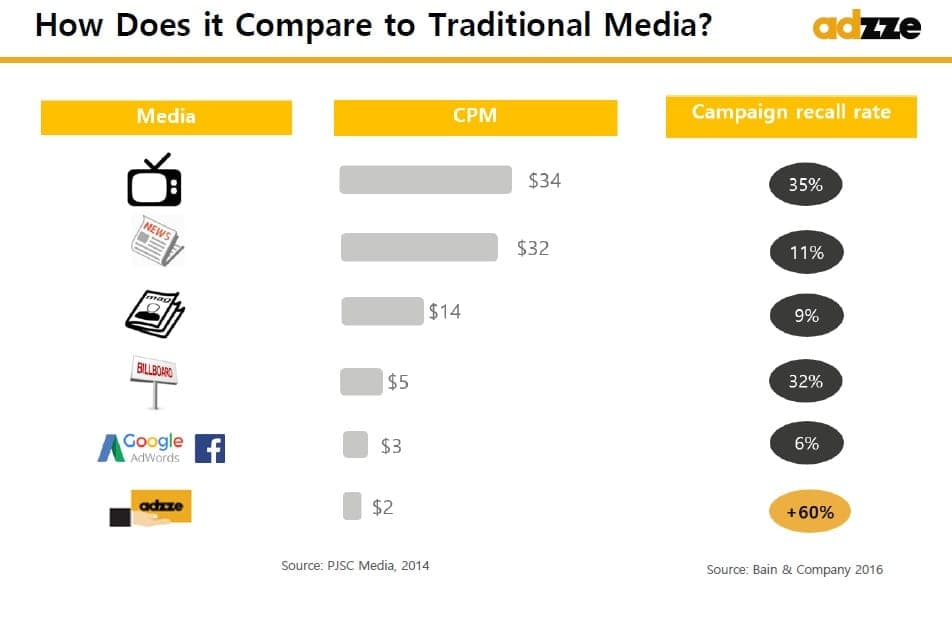Advertising boxes are emerging as simple and effective way to advertise brands reaching consumers in their household.
The future of OOH Advertising
As the effects of the economic impact of COVID-19 crisis continue to spread with the advertising industry, advertisers start feelings its destructive effects. Marketers are facing a challenge to adapt the advertising message and tactics. Traditional billboards will not be effective as the consumers will be more distanced and spend more time in their homes.
A survey conducted by the platform Numerator indicated many industries are shifting their advertising messaging. As example, restaurants are pivoting to food delivery message. The food industry has been quick to pivot their messaging to focus on in-home delivery options. The increased “work from home” periods will naturally lead to an increase in the time spent at home. Traditional OOH will be replaced by in-home advertising.

Adzze has been working with its clients to adapt to a more sensitive message. The team has been extending the capabilities to offer advertising options that can reach the consumers at their safest place: at home. One of these concepts uses pizza boxes as advertising space that gets delivered at the homes of the audience. Think of this as small moving billboard that your target audience will grab in their hands. Studies demonstrated that this type of ads can evoke an 80% recall rate (8 out of 10 households individuals remember to see an ad on the pizza box) with an average ROI of 150%. This means, for every 1 dollar the advertiser invested in a pizza box advertising campaign, they received at least additional 2.5 dollars of sales. For more details see the article Estimating the ROI of Pizza Box Marketing.
Traditional TV viewing has dropped from 25 hours a week in 2011 to just shy of 16 hours a week in 2018 mainly by younger audiences.. Nielsen’s 2018 Audience Report (1) found that Americans 18-34 averaged about 2.5h of traditional TV viewing per day – significantly less than in 2011. Pay-TV penetration is expected to fall to 70% by 2020.
Viral Marketing
Many small and medium sized companies in the US were urged to find innovative ways of effective advertising with restricted budgets. They attempted to equalize their size-related disadvantages compared to large companies by means of unconventional ways of advertising which they adjusted fast and flexibly to changing market conditions (3). At that time, these guerrilla instruments were considered revolutionary because they were substantially different to classical advertising. As consumers did not inevitably recognize guerrilla activities as advertisement, they belong to the so called “below the line”-measures (3).
One emerging trend is In-the-Hand Advertising. This concept relies on placing ads on consumables that the target audience can’t ignore as they have to take them in their hands. Such consumables can be:Custom Coffee Sleeves, Door HangersPizza Box Tops, Printed Coasters, Pharmacy Bags, Hotel Key Cards.
Here some practical examples:
An anti-DIU awareness campaign that can be placed on beer coasters in NYC bars
A healthcare message on branded pharmacy bags in reputable pharmacy venues close to hospitals
The new entertainment center offering a coupon discount on coffee cups targeting millennials
A high-end product advertised on hotel room key cards targeting travelers
The new fitness center offering a promo code on pizza boxes after ingesting a decent amount of calories!
In-Home Advertising with Pizza Box Marketing
Fortunately, Adzze’s new age marketing strategies offer innovative ways to navigate the storm and help brands to take their message into the homes of the consumers. Unique advertisement ideas have surfaced across the landscape; these strategies include placing ads pizza boxes and door handles that can reach the consumers at their homes. As simple as they sound, they generate guaranteed impressions delivering the ads at consumer’s homes.
The advertisement is printed on pizza boxes (or pizza toppers) and shipped to the pizzerias that the advertiser selected. The advertising pizza venues distribute to the consumers locally or they deliver at their homes. These venues are recognized pizza chains, so the advertiser has exposure to reputable brands. The pizza box ads get delivered in the hands of the consumers at their homes reaching on average 45 min of brand exposure. Sometimes the consumer leaves the pizza in the fridge generating additional exposure. On average, each Pizza Box Advertising venue delivers 2,000 pizza box ads per month with an estimate 1.8M impressions/month.
There are few reasons why marketers would choose Pizza Box Advertising instead of other traditional media vehicles:
High Brand Recall
The pizza box ads create a surprise effect making it more memorable. Studies show that this type of ads can evoke an 80% recall rate (8 out of 10 households individuals remember to see an ad on pizza boxes)
Low Cost
The budget used to place a 1 billboard on a high traffic highway for 1 month can be re-allocated to distribute 60,000 pizza boxes. This is enough to cover all households of a small town in the USA.
High Return on Advertising Spend
The average ROI is 150%. This means, for every 1 dollar the advertiser invested in a pizza advertising campaign, they received at least additional 2.5 dollars of sales.
Advertising Boxes: Marketing tactics
Branded pizza advertising boxes is an advertisement strategy in which a company uses surprise and/or unconventional interactions in order to promote a product or service. The core principle of the branded pizza advertising boxes approach is to surprise consumers with unexpected activities in order to draw their attention to the advertising message. Surprise leads to a change in the cognitive activation. The placement of advertising in unusual and unexpected places often with unconventional methods and being first or only ad execution to do so. Thus type of message leads to enhanced assimilation of the message.
Advertising boxes: how does it work?
The message of the advertiser are printed on branded advertising boxes (or pizza box toppers) and distributed to the network of pizza venues. The venues are usually recognized pizza chains so the advertisement has an exposure to reputable brands. The pizzerias deliver either in the hands of the consumer or at their homes reaching on average 45 min of brand exposure.
The ad is placed on the center of the pizza advertising box generating guaranteed impressions. Sometimes the consumer leaves the pizza in the fridge generating additional exposure and more impressions. The unconventional and unexpected nature of this type of advertising enables better perception and assimilation of the message. Branded pizza boxes generate more impact than traditional OOH media. On average, each pizza venue delivers 2,000 ads per month with an estimate 1.8M impressions/month.

For purpose of comparison, consider the costs of a traditional OOH as benchmark, e.g. Billboards. The costs of billboards depends on format, circulation and demographics. Traditional billboards can cost between $14,000 and 20,000/month in larger market. For the same cost, the advertiser can place its message on 65,000 branded pizza boxes at 32 different venues during the same period of time.
Source:
- Nielsen’s 2018 Audience Report. The State of Traditional TV: Updated With Q3 2018 Data Arris’ Consumer Entertainment Index
- Arris’ Consumer Entertainment Index Survey
- Kimmel, A.J., 2005. Introduction: Marketing Communication in the New Millennium. In: Marketing Communication-New Approaches, Technologies and Styles, Kimmel, A.J. (Ed.). Oxford University Press, Oxford, pp: 1-6.






